
NY drinks NY wines: History and hybrids
New York Wines: Disaster in the Beginning
Historians have documented the fact that grapes were first introduced to New York by the Dutch (1647-1664); sadly, the crops failed. A few years later, the French Huguenot settlers in Ulster County tried to plant European varietals (1667) and they too were unsuccessful.
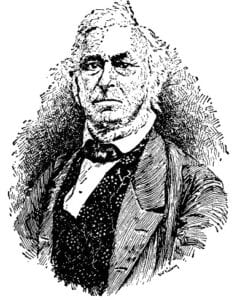
William Robert Prince (1795—1869)
Finally, in 1816 the Isabella grape was planted by William R. Prince (a descendant of Thomas Prince, an early Governor of the Plymouth Colony) in Linnaean Gardens (Queens, NY) and 2 years later (1818), Elijah Fay planted the first vineyard in Chautauqua County.
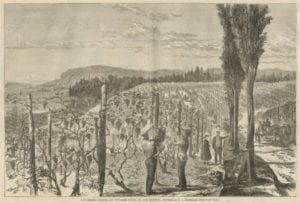
A few years later (1827) the first commercial vineyard and winery in the Hudson Valley opened (planted by Richard Underhill on Croton Point on the Hudson River). The Underhill’s are considered to be the first dynasty in American viticulture. It is the size and longevity of these vineyards that gives them the right to be considered the real founders of the wine-growing industry in New York.
Two years later (1829), in his rectory garden, the Revered William Bostwick planted the first vineyard in the Finger Lakes (Hammondsport, NY). Bostwick encouraged his neighbors to plant cuttings from the few Isabella and Catawba vines he was growing.
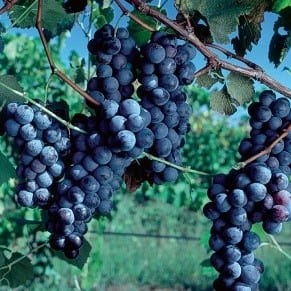
However, it took another decade for the wine industry to go commercial in the Hudson Valley. Finally, in 1839 Jean Jacques opened Blooming Grove (later rebranded as Brotherhood Winery) and by 1853 the Concord grape variety (introduced by Ephraim Bull of Concord, NH) became a popular wine and table grape. The Taylor Wine company entered the industry in 1880, followed by Widmer’s Wine Cellars in 1888 – placing New York on the world’s wine-making map. These enterprises produced sparkling and dessert wines (including ports and sherries), as well as table wines.
Wineries Expand
The Farm Winery Boom took place in the 1960s-1970s with new winery entrepreneurs. The entries included Benmarl Wine company and Cascade Mountain Vineyard (Hudson River Region), with Bully Hill Vineyards and Dr. Konstantin Frank’s Vinifera Wine Cellars in the Finger Lakes.

The Farm Winery Act (1976) opened the door to ownership and operations for a winery to produce less than 50,000 gallons of wine per year and sell directly to the consumer on the farm; today farm wineries can produce up to 150,000 gallons per year and can market wines to restaurants, retail and wholesale trade. As the Act evolved, it allowed winemakers to buy grapes from other New York growers and sell their wines in the same system, as long as the wines were made with 100 percent New York grapes.
Wineries continued to increase (1976-2017), reaching approximately 405, with 302 in Federally recognized viticulture regions: 20 in Lake Erie, 129 in the Finger Lakes, 62 in the Hudson River Region, 76 on Long Island, 7 I along the Niagara Escarpment and 7 in the Champlain Valley of New York with 103 wineries in other areas of the state.
Size Matters
Most new wineries are small, family-operated and focus on limited production of premium varietal table wines with the entire process, from planting of vines to wine marketing, controlled by the family. In addition to winemaking, visitors to the wineries are able to experience tours of the vineyards, and wine tastings and this aspect of the industry attracts 3 million tourists to New York each year.
NY Wine Industry Today
Today, New York is the nation’s third largest wine producing state with average annual production of approximately 20-million gallons. New York has 10 officially recognized viticulture areas that are compared to the French, “appellations of origin” and include Lake Erie, Niagara Escarpment; Finger Lakes; Seneca Lake; Cayuga Lake; Hudson River, Long Island; The Hampton, Long Island; North Fork of Long Island; and Champlain Valley of New York.
8th Annual NY Drinks NY. Workshop Focus

At a recent New York drinks NY wine event, scholars, sommeliers, buyers, sellers, and writers convened to learn about some of the unique hybrid grapes growing in New York State.

NY’s Hybrid Grapes
What is a hybrid grape? Hybrid grapes are grape varieties that are the product of crossing two or more Vitis species. They are also referred to an inter-specific crossing or “Modern Varieties” and have excellent tolerance to powdery mildew, other fungal diseases, nematodes and phylloxera.
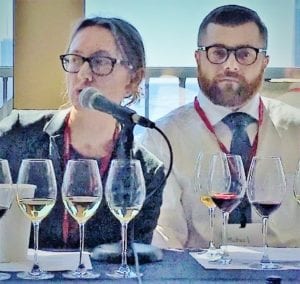
New York Hybrid Grapes Presented
At the NY Drinks NY event, Sommelier Pascaline Lepeltier, MS and viticulturalist Mike Colizzi of the Cornell Agriculture Experiment Stations, Geneva, NY, presented a few of New York State’s hybrid grape varieties, including:

Vignoles. Developed by J. F. Ravat, a French hybridizer (1929), Vignole is a cross between Pinot Noir and a Seibel hybrid. Viticulture characteristics include: Hardy, late-ripening and moderately vigorous vine; moderate yielding with small, compact clusters. They are, however, susceptible to powdery mildew and bunch rot and capable of acquiring “noble rot” which, thankfully, produces excellent late harvest wines.
Vilification: Cool, tank fermentation; no malolactic fermentation; no barrel aging. Vignola’s are always finished with at least 1 percent residual sugar and frequently used to make sweet, late-harvest wines. Vignoles present an aromatic and tropical fruit nose but is somewhat one-dimensional and the natural high acidity must be balanced with sweetness. Late harvest wines have a strong aroma of apricot.
Demand for Vignoles is growing due to numerous awards in major competitions of late harvest and ice wines. These grapes can make high quality table wines and consumers are learning that it pairs well with spicier versions of Mexican and Oriental cuisine.
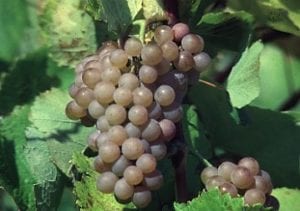
Traminette. (Formerly known as NY65.433.13). Officially introduced at the 4th International Symposium on Cool Climate Viticulture and Enology in Rochester, NY (July 1996), the Traminette is the result of a cross of Janes Serve 23.146 x Gewurztraminer by H.C. Barrett in 1965 at the University of Illinois.
Originally intended to be a table grape with Gewurztraminer flavor characteristics, this grape is distinguished by its superior wine quality combined with good productivity, partial resistance to several fungal diseases and cold hardiness. It is a late mid-season white wine grape that produces wine with pronounced varietal characteristics likened to one of its parents, Gewurztraminer.
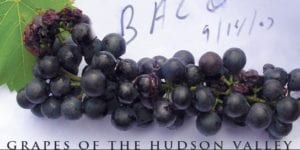
Baco Noir. Monsieur Francois Baco (1865- 1947), was a teacher, living in Belus, Landes, Armagnac Province, France (south of Bordeaux). This French-American hybrid grape variety is produced as a red wine in NY State.
Its origins date back to 1894 when Baco crossed Follet Blanche (a traditional grape variety used to make brandies in Armagnac) with an unknown member of the New World’s Vitus riparian family (also known as “riverbank” or “riverside” grapes that are found along the banks of the eastern part of North America from southern Canada to the Gulf of Mexico to the Rocky Mountains). The intention was to create phylloxera-resistant vines that retained their French character. Baco was bred in 1902 and commercially released in 1910.
Light to medium body, with good acidity and a preference for cooler climate, Baco Noir is a grower-friendly alternative to Pinot Noir. If Baco is left on its skins for more than 7 days as it ferments – it can, with care, have many big Bordeaux-like qualities. It has a robust and aromatic flavor – cedar, tobacco, leather and chocolate. The complex fruit flavors include black cherries, black berries and prunes. It may also present herbal notes of black pepper, licorice, cinnamon and eucalyptus.
Baco, made in a lighter style, is reminiscent of a Burgundian Pinot Noir that presents a rich nose whose fruits trigger memories of red raspberries, black raspberries, blueberries, cherries and strawberry jam. The herbal notes include more muted flavors of lavender, black pepper, mint and licorice.
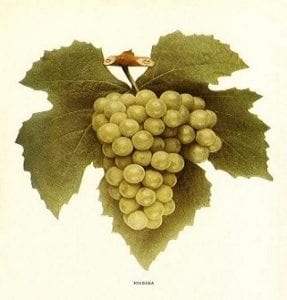
Niagara. This is a light-skinned hybrid variety grown mainly in the northeastern US, particularly around the Great Lakes Region. Created in the NY country of Niagara in the mid-19th century from the Concord grape variety (perhaps a cross between a wild Vitis labrusca variety and an unknow Vitis vinifera variety) and the labrusca Cassady. Wines from Niagara are light and present a “foxy” aroma.
Niagara is a high-yielding grape that is resistant to harsh, continental winters. It can be made into wines as diverse as Burgundian Pinot Noirs, Bordeaux-like Cabernet Sauvignons, light young fall wines or nouveaux, and even rosé. It presents a deep color, lots of berry and plum fruit, and delivers high acid levels that pair well with barbecued meats. It also ages well.
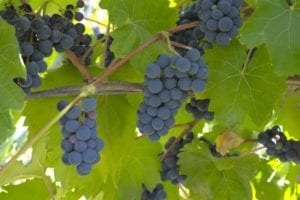
Marechal Foch. The grape is a cross of Gold Riesling and riparia/rupestris hybrid and made by Eugene Kuhlmann of Alsace. Viticulture characteristics include: vigorous and early-ripening, small to moderate yields of small, loose clusters of blue-black grapes. This hybrid is disease resistant and withstands hardy winters although early bud breaks can result in damage to shoots by late spring frosts.
For additional information, visit newyorkstatewinegrapegrowers.org.
© Dr. Elinor Garely. This copyright article, including photos, may not be reproduced without written permission from the author.
